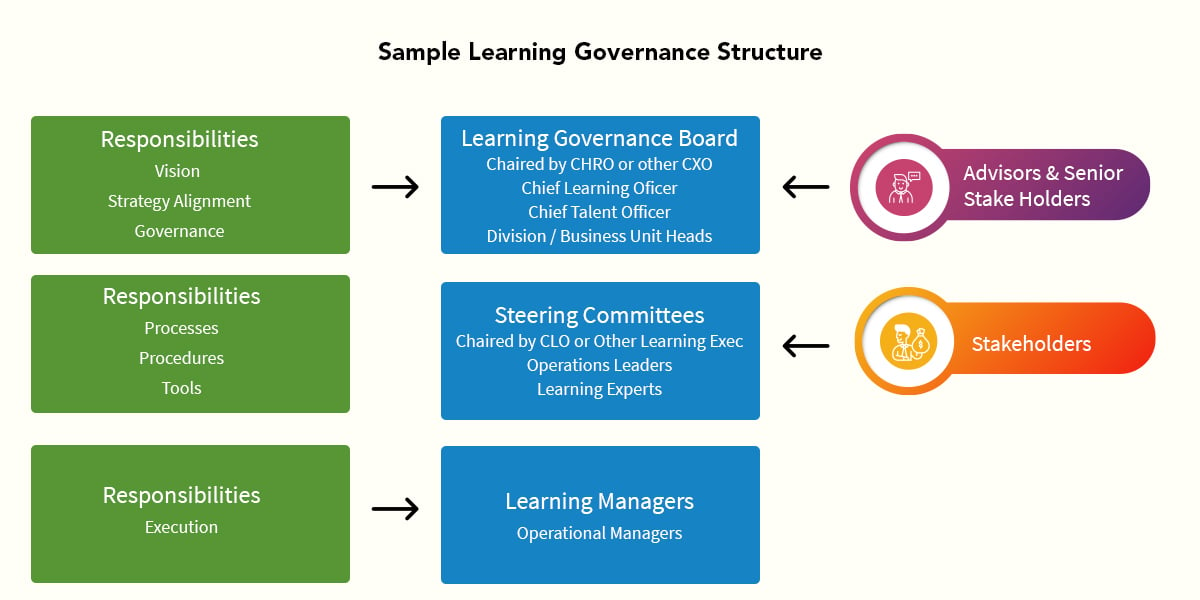
Is your learning and development (L&D) organization stuck in the middle between what your top executives say they want and what your learners say they need? Does it feel like you are bailing water with a teacup against an incoming tide?
If so, we don't wonder. Seventy-nine percent of CEOs believe a lack of essential skills threatens the future growth of their organization. Yet senior learning and development (L&D) leaders say they don't get enough direction from the top, and that the organization doesn't value learning. Only 57% of believe L&D aligns with the business.
We can't give you a magic solution that will turn all that around, but we can show you how hard work and a solid plan can get you to where:
- learning is a strategic function of the business, driven by top management.
- People across the organization invest themselves in making learning work.
- The act of learning becomes an integral work function across the organization.
- The impact of learning is how the organization measures and judges learning's contribution to the business.
The solution is in a learning governance framework.
Governance
The entire universe and everything in it tend toward entropy, which is the universal tendency toward disorder. Any energy that we (or any celestial body) put into preventing disorder has a price in energy.
It works that way in organizations, too. Without governance, organizations of any size trend towards chaos as each person in it reacts "in the moment" and does whatever they think is necessary to solve problems and get things done.
The primary function or duty of the Board of Directors is to govern or control the organization to make sure everything runs smoothly. The board governs:
- policies and objectives of the organization,
- annual budgets,
- financial resources,
- salary packages for the company's management team,
- declaring dividends to shareholders during the required annual general meetings,
- compliance with legal requirements, tax regulations, and compliance regulations, and
- ensuring prompt and regular payment of salaries and wages.
Learning Governance
In the same way, your learning function requires a governing body to help it run smoothly:
- managing learning as a strategic business process, ensuring that the learning function meets the needs and priorities of the organization's business goals;
- building a shared vision for workforce development, enabling employees to fulfill the organization's promises to its customers; and
- establishing governance of learning processes, procedures, and the tools used to create programs linked to strategic objectives.
To put it in simple terms, good governance will: .png?width=300&name=MicrosoftTeams-image%20(81).png)
- Assign accountability
- Define priorities
- Allocate budget and resources
- Drive actionable decision-making
- Facilitate transformation
The CEO invests the authority and responsibility for the learning mission in a learning governance board or council. You can call it anything you like.
Learning Governance Structure and Development
How you structure your learning governance function will be unique to your organization. It will depend on your organization's culture, maturity, and how learning gets done in your organization. The structure will grow as your learning organization develops its governance capability.
Start Where You Are
If your learning organization has not yet matured into a strategic business function, operates as an independent service provider, or gets little or no direction from top management, your organization is not ready for a Learning Governance Council. You may want to start with a less formal structure led by HR.
Your learning governance program's objectives may be different from those of a mature governance function. Your mission will be to build readiness to collaborate in learning and prove the value of that collaboration.
- Assemble a team. You will have pockets of learning excellence and good ideas across the organization. The people who drive that excellence will be excellent candidates for your learning council.
- Identify Common Learning Practices. You will most likely have fragmented learning efforts hidden in silos across the organization. Find out what these efforts have in common and bring them together for better efficiency and results.
- Drive Efficiency. Identify and eliminate duplication of effort and inefficiencies across the organization. Measure and report on the results of your efforts.
- Organizational Readiness. Build the organizational capability for cross-functional collaboration on learning.
- Drive Value. Leverage the relationships you build to focus the organization on the value of learning, not its cost.
Identify and Satisfy Learning Objectives
Every unit and sub-unit in your organization will have its unique learning needs and objectives. Form them into steering committees that will drive the execution of learning in their business functions.

Bring the people who lead those units into your governance program and show them how, as stakeholders, they have a voice in how learning happens, and that you aim to support them in achieving their goals.
The broader your organization perspective and the more involvement you have, the more your efforts will align themselves with your business strategy.
By this stage of your development, you will have seated steering committees and learning leaders throughout your organization that understand the value of learning and how it drives business results.
Connect to the Enterprise
The third part of the development is the discussions with your top executives about aligning learning to business strategy. Co-opt the CEO into leading learning and development for the company.
How you do that will depend on your relationship with the CEO. You could introduce the idea of entropy and explain no matter how well you organize it; any program will devolve unless you pay the energy price.
- The Executive Learning Council must establish and publish objectives for workforce development so that steering committees can align their efforts to it.
- The Council should measure the strategic value of learning and its impact on organizational growth, productivity, and transformation to the Board of Directors.
- The CEO should communicate support for workforce learning and take part in learning events.
Keep the Energy Flowing
The price for all the excellence you will create is ongoing vigilance. Keep the energy going with ongoing communications about recent developments in learning and how they can affect your organization. Keep learning top of mind and report on learning successes to everyone in the organization.
If you are diligent about the development of your governance, learning will become a strategic function of the organization embedded in work functions across the organization, with a far-reaching impact on organizational performance.

